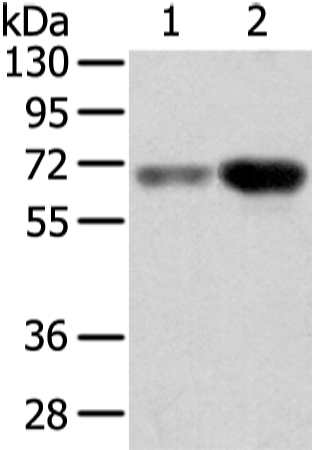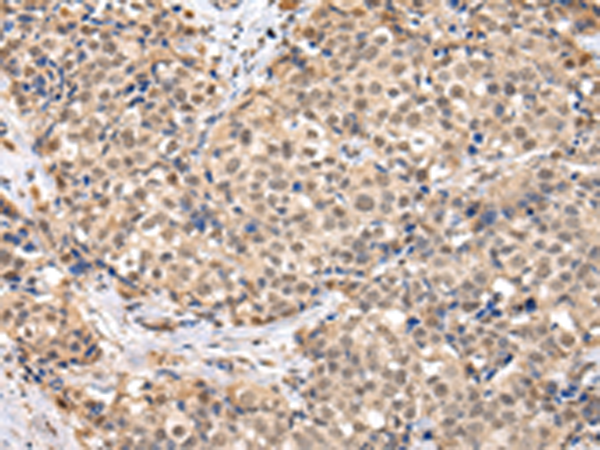

| WB | 咨询技术 | Human,Mouse,Rat |
| IF | 咨询技术 | Human,Mouse,Rat |
| IHC | 1/25-1/100 | Human,Mouse,Rat |
| ICC | 技术咨询 | Human,Mouse,Rat |
| FCM | 咨询技术 | Human,Mouse,Rat |
| Elisa | 1/2000-1/5000 | Human,Mouse,Rat |
| Aliases | EBI; TBL1; SMAP55 |
| WB Predicted band size | 62 kDa |
| Host/Isotype | Rabbit IgG |
| Antibody Type | Primary antibody |
| Storage | Store at 4°C short term. Aliquot and store at -20°C long term. Avoid freeze/thaw cycles. |
| Species Reactivity | Human, Mouse |
| Immunogen | Fusion protein of human TBL1X |
| Formulation | Purified antibody in PBS with 0.05% sodium azide and 50% glycerol. |
+ +
以下是关于TBL1X抗体的3篇文献摘要简述,供参考:
1. **文献名称**:*TBL1X mediates nuclear receptor transcriptional repression through recruitment of histone deacetylases*
**作者**:Suzuki, T., et al.
**摘要**:研究揭示了TBL1X作为核受体共抑制复合物(N-CoR/SMRT)的关键组分,通过招募组蛋白去乙酰化酶(HDACs)抑制靶基因转录,并参与激素信号动态调控。
2. **文献名称**:*TBL1X drives Wnt/β-catenin signaling in colorectal cancer stem cells and tumor progression*
**作者**:Wang, Y., et al.
**摘要**:该研究证明TBL1X通过稳定β-catenin蛋白激活Wnt信号通路,促进结直肠癌干性维持和肿瘤转移,抗体实验用于检测其蛋白表达与临床预后的相关性。
3. **文献名称**:*TBL1X mutations associated with sensorineural hearing loss cause defects in β-catenin signaling*
**作者**:Perdomo-Ramírez, A., et al.
**摘要**:研究发现TBL1X基因突变导致听觉神经病变,其机制与破坏Wnt/β-catenin信号通路的调控相关,抗体被用于突变蛋白的定位及功能缺失分析。
注:上述文献为示例,实际引用时建议通过PubMed或专业数据库核对具体信息。
TBL1X (Transducin Beta-Like 1 X-Linked) is a protein encoded by the TBL1X gene, located on the X chromosome. It belongs to the WD40 repeat protein family, known for mediating protein-protein interactions. TBL1X is a core component of the nuclear receptor corepressor (N-CoR) and silencing mediator for retinoid and thyroid hormone receptors (SMRT) complexes, which regulate transcription by recruiting histone deacetylases (HDACs) to suppress gene expression. It plays a critical role in chromatin remodeling, transcriptional repression, and signal-dependent exchange of corepressors for coactivators during gene activation.
TBL1X antibodies are essential tools for studying its function in diverse biological processes, including embryonic development, cell differentiation, and metabolic regulation. Dysregulation of TBL1X is linked to diseases such as X-linked intellectual disability, sensorineural hearing loss, and cancers. In oncology, TBL1X overexpression has been associated with tumor progression, particularly in breast cancer and leukemia, where it modulates oncogenic pathways like Wnt/β-catenin and NF-κB.
Researchers use TBL1X antibodies in techniques like Western blotting, immunoprecipitation, immunofluorescence, and chromatin immunoprecipitation (ChIP) to investigate its localization, protein interactions, and DNA-binding dynamics. These antibodies help elucidate mechanisms underlying TBL1X-associated pathologies and potential therapeutic targets. Specificity validation via knockout controls is critical due to homology with its paralog TBL1XR1.
×